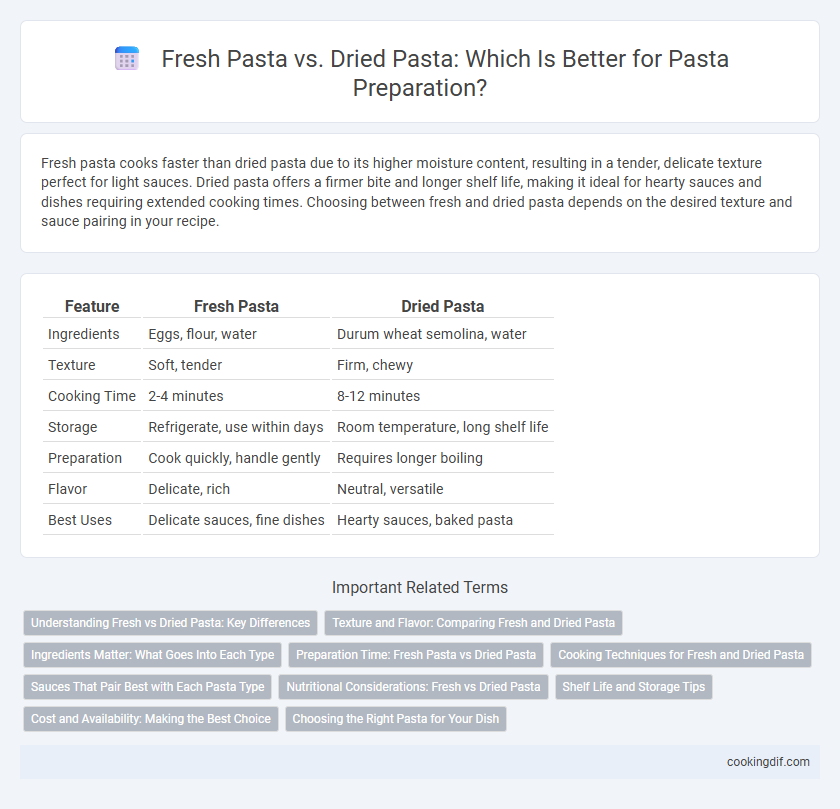Fresh pasta cooks faster than dried pasta due to its higher moisture content, resulting in a tender, delicate texture perfect for light sauces. Dried pasta offers a firmer bite and longer shelf life, making it ideal for hearty sauces and dishes requiring extended cooking times. Choosing between fresh and dried pasta depends on the desired texture and sauce pairing in your recipe.
Table of Comparison
| Feature | Fresh Pasta | Dried Pasta |
|---|---|---|
| Ingredients | Eggs, flour, water | Durum wheat semolina, water |
| Texture | Soft, tender | Firm, chewy |
| Cooking Time | 2-4 minutes | 8-12 minutes |
| Storage | Refrigerate, use within days | Room temperature, long shelf life |
| Preparation | Cook quickly, handle gently | Requires longer boiling |
| Flavor | Delicate, rich | Neutral, versatile |
| Best Uses | Delicate sauces, fine dishes | Hearty sauces, baked pasta |
Understanding Fresh vs Dried Pasta: Key Differences
Fresh pasta contains higher moisture content, allowing for quicker cooking times and a tender, delicate texture compared to dried pasta. Dried pasta, made from durum wheat semolina and water, offers a firmer bite and longer shelf life, making it ideal for hearty sauces and long-term storage. Understanding these differences helps in selecting the right pasta type for specific recipes and cooking methods to achieve optimal flavor and texture.
Texture and Flavor: Comparing Fresh and Dried Pasta
Fresh pasta offers a tender, silky texture and a rich, egg-infused flavor that enhances delicate sauces, while dried pasta delivers a firmer bite and a more concentrated wheat taste ideal for robust, hearty dishes. The moisture content in fresh pasta allows quicker cooking times, preserving its soft consistency, whereas dried pasta's longer cooking creates a chewy texture that holds up well in slow-cooked recipes. Understanding these differences helps chefs select pasta types to optimize texture and flavor profiles for various culinary applications.
Ingredients Matter: What Goes Into Each Type
Fresh pasta is typically made from a simple mixture of wheat flour, eggs, and sometimes water or olive oil, resulting in a delicate texture and faster cooking time. Dried pasta relies on durum wheat semolina and water, creating a firmer, more shelf-stable product with a longer cooking time. The difference in ingredients directly influences the pasta's flavor, texture, and versatility in various recipes.
Preparation Time: Fresh Pasta vs Dried Pasta
Fresh pasta requires significantly less cooking time, typically only 2 to 4 minutes, due to its higher moisture content and delicate texture. Dried pasta, made through dehydration, demands longer boiling times of around 8 to 12 minutes to achieve the desired firmness. This difference in preparation time makes fresh pasta ideal for quick meals, while dried pasta offers convenience and extended shelf life.
Cooking Techniques for Fresh and Dried Pasta
Fresh pasta requires a shorter cooking time, usually 2-4 minutes, due to its high moisture content, making it ideal for delicate sauces and quick preparations. Dried pasta demands longer boiling, typically 8-12 minutes, to achieve al dente texture because of its low moisture and denser structure. Techniques such as tossing fresh pasta gently in the pan with sauce preserve its tenderness, while draining dried pasta al dente and finishing it in the sauce ensures optimal flavor absorption.
Sauces That Pair Best with Each Pasta Type
Fresh pasta's tender texture and higher moisture content complement delicate sauces like light cream, butter, or simple tomato-based sauces that don't overpower its subtle flavor. Dried pasta, known for its firm bite and sturdiness, pairs well with robust sauces such as hearty meat ragu, chunky vegetable sauces, or thick pesto that cling to its denser surface. Choosing the right pasta type enhances the overall dish by matching the sauce's consistency and intensity for balanced flavor and texture.
Nutritional Considerations: Fresh vs Dried Pasta
Fresh pasta contains higher moisture levels and generally offers a softer texture with a lower glycemic index compared to dried pasta, which is denser and more shelf-stable. Nutritionally, fresh pasta often retains more protein and essential nutrients due to minimal processing, while dried pasta may have a longer shelf life but sometimes includes added preservatives. Both types provide complex carbohydrates and can be part of a balanced diet, but fresh pasta may be preferable for those seeking fewer additives and a quicker cooking time.
Shelf Life and Storage Tips
Fresh pasta typically has a shelf life of 2 to 3 days when refrigerated at 40degF (4degC), requiring airtight containers to maintain moisture and prevent spoilage. Dried pasta, with moisture content below 12%, can be stored in a cool, dry pantry for up to 1 to 2 years, making it a convenient pantry staple. For optimal freshness, store dried pasta away from heat and humidity, and keep fresh pasta tightly wrapped or frozen if longer storage is needed.
Cost and Availability: Making the Best Choice
Fresh pasta typically costs more than dried pasta due to its perishable nature and shorter shelf life, making it less readily available in most grocery stores. Dried pasta offers a more cost-effective option with extended shelf stability, allowing for bulk purchases and long-term storage. Choosing between fresh and dried pasta depends on balancing the higher expense and limited availability of fresh pasta against the affordability and convenience of dried varieties.
Choosing the Right Pasta for Your Dish
Fresh pasta, made from eggs and soft flour, offers a tender texture and cooks quickly, making it ideal for delicate sauces or dishes like fettuccine Alfredo and ravioli. Dried pasta, crafted from durum wheat semolina, provides a firmer bite and longer shelf life, perfect for hearty sauces such as Bolognese or robust baked casseroles. Selecting the right pasta depends on sauce consistency and cooking time, ensuring the pasta complements the dish's flavor and texture.
fresh pasta vs dried pasta for preparation Infographic

 cookingdif.com
cookingdif.com